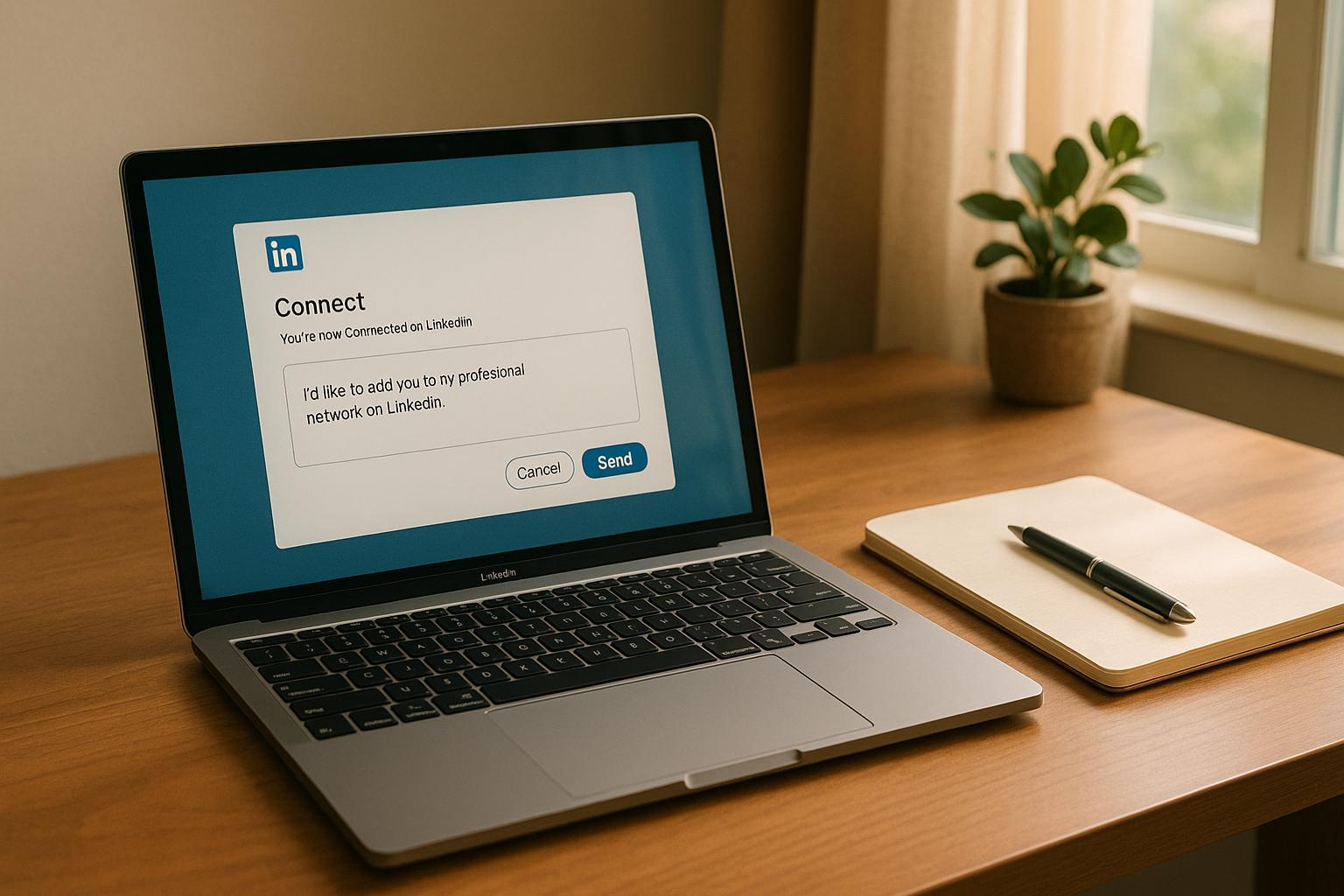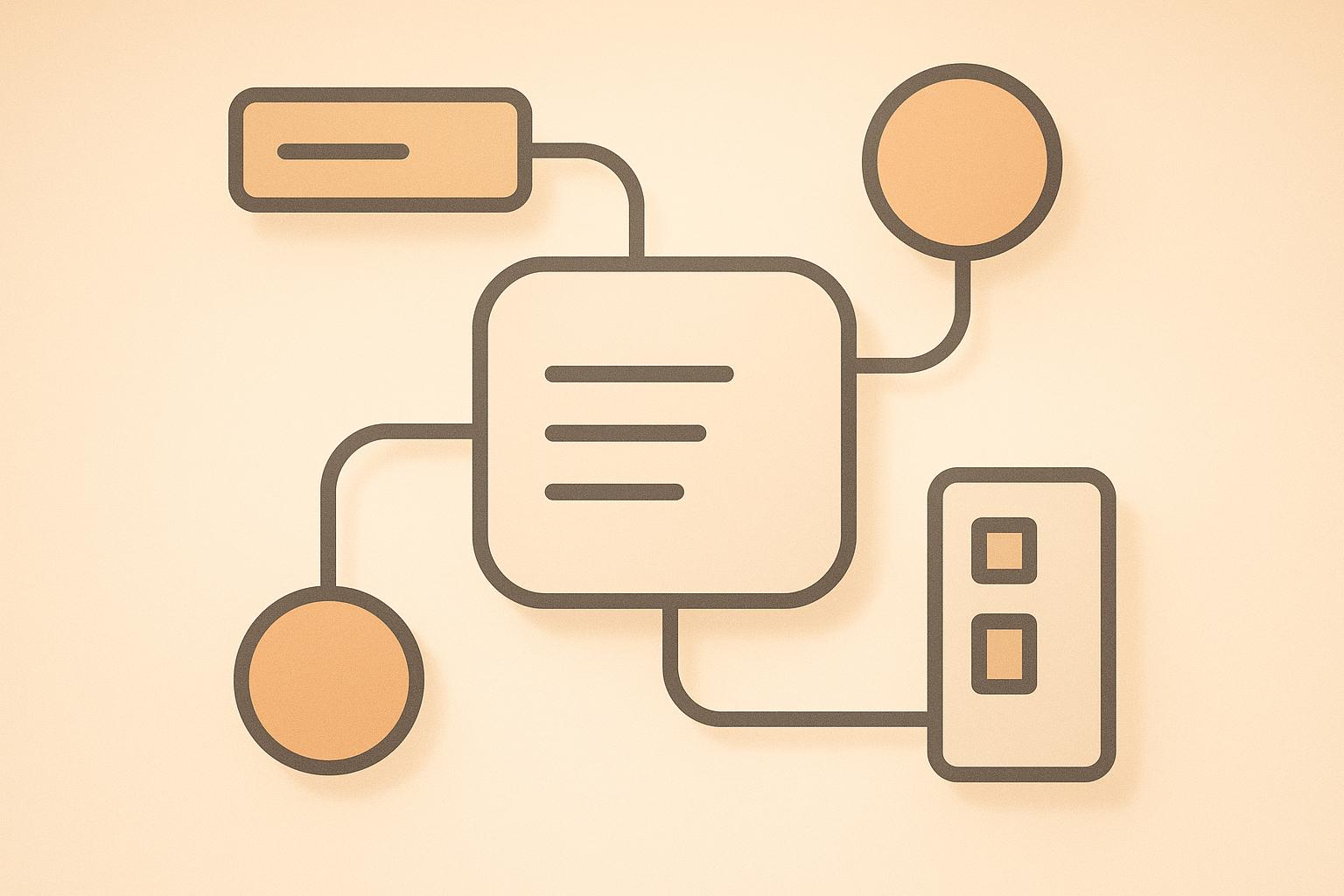
.avif)
Julien Gadea
Julien Gadea specializes in AI prospecting solutions for business growth. Empowering businesses to connect with their audience with SalesMind AI tools that automate your sales funnel, starting from lead generation.
If you want your LinkedIn connection requests to stand out, personalization is key. Most requests fail because they’re generic, impersonal, and focused on the sender’s goals. A tailored approach, on the other hand, increases acceptance rates and opens the door to meaningful conversations. Here’s how to get it right:
- Personalize your message: Reference something specific about the recipient, like a recent post or shared connection.
- Focus on their perspective: Show how connecting benefits them, not just you.
- Keep it short and clear: Use LinkedIn’s 300-character limit wisely with a friendly, non-pushy tone.
For example:
"Hi Alex, I noticed your recent article on scaling B2B sales teams. I’ve worked with similar companies and would love to connect and share insights!"
Success also depends on optimizing your profile, targeting the right prospects, and respecting LinkedIn’s weekly connection limits (80–100 requests). Tools like SalesMind AI can help scale outreach while maintaining a personal touch by automating research and message suggestions.
B2B LinkedIn Connection Requests Review: Dos and Don'ts
LinkedIn Connection Request Basics
Understanding how LinkedIn connection requests work is key to building a successful outreach strategy. The platform has specific rules and algorithms designed to ensure connections are meaningful and to prevent spam.
What Makes a Connection Request Work
Personalization matters. Sending generic requests often leads to lower acceptance rates. By explaining how you know the recipient or why you want to connect, you increase your chances of acceptance and reduce the likelihood of being flagged as spam [2][3].
The most effective connection requests include three key ingredients: relevance, value, and authenticity. Show that you’ve done your homework - demonstrate that you understand the recipient’s business or challenges. Instead of starting with what you want, highlight what you can offer or how you can collaborate.
LinkedIn Limits and Algorithm Rules
LinkedIn has strict limits to keep spam in check. Knowing these boundaries helps you craft a better outreach strategy. You can send up to 100 connection requests per week, though 30-50 daily requests are safer for well-established accounts [1][2]. These limits reset exactly one week after your first request, not based on the calendar week.
Your total network is capped at 30,000 first-degree connections. Once you hit this limit, you can only gain followers, not additional connections [2]. This makes it critical to prioritize meaningful relationships over sheer numbers.
LinkedIn uses six metrics to monitor account health: Active Sessions, Profile Age & Network Size, Verification & Account Completeness, Last Month Activity, Connect Rate + Withdraw Queue, and Reply Rate + Block Rate [1]. Poor acceptance rates and too many pending requests can hurt your account’s standing, making future outreach more difficult [2].
Withdraw unaccepted requests after one to two weeks to maintain a healthy account [1][2].
LinkedIn enforces its rules with soft warnings for minor violations and hard restrictions for repeated or major offenses [2]. To stay on the safe side, maintain your activity during standard business hours and avoid being online for more than eight hours a day. Logging in and out at regular intervals can also help keep your account in good standing [1][2].
Setting Up Your LinkedIn Profile for Higher Acceptance Rates
Think of your LinkedIn profile as your digital business card - it’s the first thing people see, and it can make or break their decision to connect with you. A polished profile not only builds trust but also increases the chances that your connection requests turn into meaningful interactions. Did you know profiles with a photo are 14 times more likely to be viewed by others? [4] That’s why putting effort into your profile photo and cover image is so important.
Choosing Your Profile Photo and Cover Image
Your profile photo is like a virtual handshake - it sets the tone for how people perceive you. Smiling with teeth, for example, has been shown to double perceived likability [4]. So, what makes a great profile picture?
- Use a recent, professional photo that’s cropped so your face fills about 60% of the frame. This means the image should include your face from just above your head to the top of your shoulders [4].
- Skip the selfies. Instead, have someone else take the photo to ensure a natural and professional appearance.
- Choose a clean, simple background that won’t distract from your face. Neutral settings like natural environments or painted walls work well [4].
- Dress like you would for work, sticking to solid colors that pop but don’t overwhelm [4].
- Use soft, natural lighting to avoid harsh shadows or overexposure. Steer clear of direct sunlight or backlighting [4].
Your cover image is just as important - it’s a chance to reinforce your professional identity. Stick to the recommended dimensions of 1584 x 396 pixels [5]. Use this space to highlight your brand or industry. For example, you could incorporate elements of your company’s branding or showcase something relevant to your field. Just be mindful of the bottom-left corner, as your profile photo will cover that area [6].
Writing Connection Requests That Get Accepted
When it comes to LinkedIn, your connection request is where personalization meets purpose. Think of it as your digital handshake - crafted to make a strong impression in just 300 characters. The upside? Most people send generic, uninspired messages, so a thoughtful, well-tailored note instantly sets you apart.
How to Structure Your Connection Message
To craft a compelling connection message, follow this structure: start with a personalized opener, include a clear value statement, and finish with a polite, low-pressure call to action. This approach works because it shows genuine interest, highlights mutual benefit, and makes it easy for the recipient to engage.
Begin with something specific about their background or recent activity. Avoid generic lines like "I'd like to connect." Instead, reference something meaningful, such as "I noticed your post about scaling customer success teams" or "As a fellow Northwestern alum." This signals that your message is not a mass send-out.
Next, explain why connecting makes sense - focus on their perspective, not yours. For example, instead of saying, "I'm an expert in customer success", you could write, "I've worked with SaaS companies to improve key metrics and would love to share insights that might align with your goals." This sparks curiosity about how your expertise could align with their needs.
Wrap up with a friendly, non-pushy request. Phrases like "Would love to exchange ideas" or "Happy to share some insights" feel approachable and conversational, unlike more direct asks like "Let's schedule a call." Remember, the goal is to connect, not pitch.
Here’s how this might look in action:
"Hi Sarah, noticed you're hiring SDRs at TechFlow. I've worked with similar companies to streamline their sales hiring process. Would love to share some insights if that’s helpful!"
This framework makes personalization easier, but the real magic happens when you invest time in researching your prospects.
Researching Prospects for Better Personalization
To personalize effectively, dive into your prospect's LinkedIn profile and activity. LinkedIn is a goldmine of information if you know where to look. Start with their recent activity - posts, comments, and shares often highlight their current challenges or interests. For example, a VP of Sales discussing pipeline management is likely more receptive to sales-focused outreach than someone sharing vacation photos.
The About section is another treasure trove of insights. Look for phrases like "passionate about" or "focused on", which often reveal their professional priorities and pain points. These details can help you craft a message that resonates.
Don’t overlook mutual connections - they can be a great way to establish credibility. If you share contacts, mention them naturally, such as, "John Martinez suggested I reach out", or "I noticed we both know Lisa Chen from Salesforce." This instantly builds trust.
Stay informed about company news or recent milestones. For instance, a company that just secured Series B funding is likely in a growth phase and may be open to strategic advice. Industry blogs, company pages, and news sites are excellent sources for this kind of context.
Finally, dig into their Experience section. A prospect’s career trajectory often hints at their ambitions and expertise. For example, someone who moved from an individual contributor role to management in just a few years is likely growth-oriented and results-driven. Tailoring your message to align with their journey can make all the difference.
Using SalesMind AI for Automated Personalization

While manual research works wonders for high-value connections, it can get overwhelming when you're reaching out to dozens of people weekly. That’s where tools like SalesMind AI come in, blending efficiency with authenticity.
SalesMind AI scans profiles, activity, and company data to instantly generate personalized message suggestions, saving you hours of tedious research. This allows you to focus on top-priority prospects while still maintaining a personal touch.
The platform also features a unified inbox that consolidates responses. When someone replies to your request, you can access their full profile and conversation history in one place, making follow-ups feel seamless and informed.
Another standout feature is lead scoring. This helps you identify which prospects deserve the most attention. High-scoring leads might warrant custom-crafted messages, while others can benefit from AI-assisted personalization with your final tweaks to ensure they sound genuine.
This method ensures your outreach doesn’t feel automated or robotic. By letting AI handle the heavy lifting of research, you free up time to inject your own expertise and personality into the message. The result? Scalable, yet personal communication that builds meaningful connections.
sbb-itb-817c6a5
Improving Acceptance Rates and Staying Within LinkedIn Rules
The success of your LinkedIn outreach hinges on strategic planning and keeping your account in good standing. Since LinkedIn's rules and algorithms significantly influence your results, it's crucial to align your tactics with their guidelines. By combining these strategies with the earlier techniques, you can create a more effective outreach process.
Finding and Targeting the Right Prospects
Once your profile is optimized, the next step is identifying prospects who align with your Ideal Customer Profile (ICP). Focus on quality rather than quantity - sending random connection requests is far less effective than targeting individuals who are genuinely interested in your industry. Here’s a key insight: prospects are three times more likely to accept a connection request if you’ve engaged with their content beforehand [8].
Take advantage of LinkedIn's search filters to refine your prospecting. For instance, look for professionals who have recently changed jobs, as they may be more open to new opportunities. Additionally, those with a Social Selling Index (SSI) score above 70 often experience 45% more opportunities - a benchmark worth aiming for [8].
Managing Your Connection Requests
LinkedIn limits users to 80–100 connection invites per week [7]. To make the most of this allowance, space out your requests and focus on personalization. A well-timed, tailored message can significantly improve your acceptance rate.
Keep an eye on your outreach metrics. If your acceptance rate drops below the industry average of 30%, it’s time to rethink your targeting and messaging. Also, avoid sending multiple connection requests to people from the same company on the same day - this can trigger LinkedIn’s spam detection.
What to Do When You Hit Connection Limits
If you’ve reached LinkedIn’s weekly connection cap or face temporary restrictions, don’t worry - there are alternative ways to stay engaged. LinkedIn messages, for example, often yield a 10% response rate, which is double the 5% response rate typical of cold emails [7][8][9]. If direct connection requests are off the table, try engaging with your prospects’ content or sending personalized InMails. These can increase response rates by up to 30% compared to generic messages [7].
You can also reference your LinkedIn outreach in follow-up emails to provide context. Another effective tactic is to leave thoughtful comments on your prospects’ posts. This not only grabs their attention but may also prompt them to check out your profile - and possibly initiate a connection themselves.
During these restrictions, tools like SalesMind AI’s unified inbox become invaluable. They allow you to track interactions across different channels, ensuring no leads slip through the cracks.
Lastly, use outreach limitations as an opportunity to fine-tune your content strategy. Share posts that showcase industry insights, case studies, or thought leadership. Trigger events, such as job promotions or recent webinars, can also be excellent conversation starters. In fact, these events have been shown to boost response rates by 32% [7]. Once restrictions are lifted, you’ll be well-positioned to re-engage with your audience effectively.
Tracking Performance and Improving Your Results
To get the most out of your LinkedIn outreach, it’s crucial to keep an eye on your performance metrics and tweak your strategy regularly. By measuring key data points, you can fine-tune your connection requests and improve your results over time.
Important Metrics to Track
Start by keeping tabs on your connection acceptance rate. This metric is a direct reflection of how well your messages are crafted and how accurate your targeting is. You can calculate it by dividing the number of accepted connection requests by the total requests sent. It’s a simple yet powerful way to gauge your outreach effectiveness.
Next, pay attention to your response rate - this helps you understand if your follow-up messages are hitting the mark. Similarly, track your conversion rate to see how many of your connections turn into leads or other valuable opportunities.
Another key metric is reply speed, which can reveal how interested prospects are and whether your messages feel personalized. Be mindful of LinkedIn’s weekly limits by spreading out your outreach efforts evenly.
By consistently monitoring these metrics, you can spot trends and make data-driven adjustments to your approach.
Using Data to Improve Your Strategy
Analyzing your metrics regularly can uncover areas for improvement. For example, if acceptance or response rates drop, it might be time to revisit your targeting criteria or tweak your message templates. Sometimes, a small change - like adjusting the level of personalization or timing - can make a big difference.
Experiment with A/B testing to figure out what works best. Test variations in message length, personalization details, calls-to-action, or timing to see what resonates most with your audience.
Segmenting your prospects by factors like industry, company size, or job role can also provide valuable insights. These patterns can help you refine your Ideal Customer Profile, ensuring future outreach is more targeted and effective.
Additionally, keeping track of seasonal or weekly performance trends can give you an edge. Regularly updating and refining your message templates based on these insights ensures your strategy stays sharp.
How SalesMind AI Helps with Analytics and Optimization
This is where tools like SalesMind AI step in to simplify the process. With its real-time analytics dashboard, SalesMind AI consolidates all your LinkedIn outreach metrics in one place, so you don’t have to manually track them. It automatically calculates key indicators like acceptance rates, response times, and conversion metrics across all your campaigns.
The platform’s unified inbox is another game-changer. It tracks interactions across multiple LinkedIn accounts, giving you a clear view of your team’s overall performance. This centralized approach makes it easier to identify what’s working and replicate those strategies across your outreach efforts.
SalesMind AI also uses advanced lead scoring, evaluating factors like profile completeness, recent activity, and mutual connections to predict how likely someone is to accept your request. Its automated follow-up tracking ensures no prospect slips through the cracks while measuring engagement at each step.
With seamless CRM integration, SalesMind AI merges your LinkedIn metrics with broader sales data, offering a full picture - from the first connection to the final deal. This integration helps you calculate the true ROI of your LinkedIn outreach efforts.
Finally, the platform provides real-time optimization suggestions based on your performance data. Whether it’s refining your targeting, improving message templates, or adjusting your strategy, SalesMind AI offers actionable recommendations to help you continuously improve and achieve better results with confidence.
Conclusion: Building a Scalable LinkedIn Outreach System
Achieving success with LinkedIn outreach requires a strategy that's both sustainable and grounded in data. The methods outlined here - from refining your profile to crafting tailored messages and monitoring your progress - create a strong platform for long-term results.
Scaling your outreach effectively means finding the right balance between automation and personalization. Sure, it might be tempting to blast out generic messages to a massive list of prospects. But seasoned B2B sales professionals understand that quality always wins over quantity. Tools like SalesMind AI help strike this balance by enabling you to maintain a personal touch while reaching a high volume of prospects each month.
The results speak for themselves: SalesMind AI users see an average connection acceptance rate of 40%, a reply rate of 45%, and a pipeline value averaging $100,000 per month [10]. Additionally, companies using this platform have cut acquisition costs by 40% [11]. Instead of relying on impersonal mass messaging, these users send smarter, more resonant messages that genuinely connect with their audience.
Scalability also depends on efficient management. A unified AI inbox simplifies the process by handling responses across multiple LinkedIn accounts. This allows sales teams to focus on meaningful, high-value conversations while the AI takes care of routine replies. Tasks that once required an entire team can now be managed by a single person.
Staying compliant with LinkedIn's guidelines is another critical piece of the puzzle. The most successful users personalize every message, ease new accounts into activity with 10–15 connections per day, and maintain a healthy balance between engagement and outreach. By following these practices, SalesMind AI clients have doubled their connection acceptance rates without raising any red flags with LinkedIn [11].
As your business grows, your LinkedIn outreach strategy should evolve alongside it. Start with the basics - optimize your profile, send thoughtful connection requests, and track key performance metrics. As you scale, AI-powered tools can help you maintain a personal touch while broadening your reach. Teams that review their sales data weekly are three times more likely to consistently meet their targets [11]. Make data-driven adjustments a regular part of your process.
The future of B2B sales lies in blending human intuition with AI-driven efficiency. By adopting these strategies and leveraging tools like SalesMind AI, you’re not just improving your LinkedIn outreach - you’re creating a competitive advantage that fuels sustainable growth.
FAQs
What’s the best way to personalize LinkedIn connection requests to boost acceptance rates?
To make your LinkedIn connection requests stand out, focus on crafting a concise, purposeful message. Begin by explaining why you're reaching out - mention shared interests, mutual connections, or something specific from their profile that caught your eye. This personal touch can go a long way in increasing your chances of getting accepted.
Another smart move? Engage with their posts before sending your request. Liking or commenting on their content helps establish familiarity and shows genuine interest. Skip the generic templates and aim for a friendly yet professional tone that feels natural. These small but meaningful steps can help you build stronger, more authentic connections.
How can I optimize my LinkedIn profile to improve outreach and engagement?
To make your LinkedIn profile more effective for outreach, start with a professional profile picture that communicates trust and approachability - it’s often the first thing people notice. Next, craft a clear and keyword-focused headline that highlights your expertise and helps your profile stand out in searches. Follow this with a concise, engaging summary that emphasizes your skills and the value you bring, keeping your target audience's needs in mind.
Take the extra step to customize your LinkedIn URL - this makes it easier to share and ensures it's memorable. Stay active by sharing insightful content, commenting thoughtfully on posts, and joining discussions in relevant LinkedIn groups. These actions not only increase your visibility but also establish credibility, which is crucial for forming strong connections, particularly in B2B environments.
How does SalesMind AI make LinkedIn connection requests more personalized and effective?
SalesMind AI leverages cutting-edge AI technology to craft personalized LinkedIn connection requests. By analyzing a recipient's profile, interests, and engagement history, it ensures your messages feel relevant and resonate on a personal level, increasing the likelihood of acceptance.
What sets SalesMind AI apart is its ability to automate this customization process without losing the human touch. For B2B sales professionals, this means saving valuable time while still building genuine connections. The result? Improved engagement and more effective LinkedIn prospecting that drives better outcomes.




